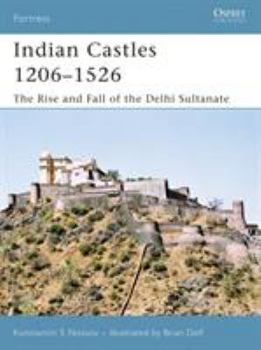Indian Castles 1206-1526: The Rise and Fall of the Delhi Sultanate (Fortress)
(Book #51 in the Osprey Fortress Series)
From the beginning of the 11th century onwards, the constant sate of war amongst the various Indian kingdoms left them open to outside attack, and Muslim Turkic tribesmen began to pour over the north-west border from modern-day Afghanistan. These raiders consolidated their successes and by 1206 a Muslim state, the Sultanate of Delhi, had been founded, which then extended its direct rule or influence over most of the subcontinent. A turbulent period followed. The Sultanate was in constant flux as five dynasties rose and fell: Mamluk or Slave (1206-90), Khalji (1290-1320), Tughluq (1320-1413), Sayyid (1414-51), and Lodi (1451-1526). 19 out of the 35 Sultans died at the hands of assassins and the Sultanate was torn by factional rivalries and court intrigues. As a consequence of this, the territory under its direct control expanded and shrank depending on the personality, fortunes and military success of each individual Sultan. This era is considered to be the defining age of Indian castle and fortification design. The instability and feudal division of the country throughout the greater part of the period led to the intense fortification of many of the provinces, as each small lord sought to bolster his position by constructing castles. It was also the period during which Indian castles started to show their defining features, elements of which would be modified in later years as the technology of siege warfare evolved. The combined influence of the Islamic and Hindu architectural tradition lends these fortifications a unique and exotic style. This book covers all the major sites of the period, including the fabled seven medieval cities on the site of present-day Delhi, as well as the most prominent sieges.
Format:Paperback
Language:English
ISBN:184603065X
ISBN13:9781846030659
Release Date:September 2006
Publisher:Osprey Publishing (UK)
Length:64 Pages
Weight:0.50 lbs.
Dimensions:0.2" x 7.3" x 9.8"
Related Subjects
HistoryCustomer Reviews
3 ratings
History buffs alert!
Published by Thriftbooks.com User , 17 years ago
This book is a volume in Osprey's large series devoted to fortresses. In just over sixty pages, it amalgamates historical accuracy with appealing presentation to present a complex subject in a way that is suitable for those without prior knowledge in Indian fortifications. The book starts with a two-page introduction that succinctly summarizes the political history of the period and makes broad remarks on castle architectural styles. As there was great political instability at the time, captured military structures were only repaired where needed. Hence castles from that period have a unique blend of Hindu and Islamic architectural motifs. The introduction is followed by a map showing the location of the castles covered in the text and a chronology of events. The first substantive chapter discusses types of castles drawing on Indian (rather than European) conventions as its basis for classification. The choice of classification helps the reader appreciate Indian castles from within their own framework rather than trying to fit their designs within a foreign framework. The chapter ends with a general discussion on the methods used for castle construction. The next chapter discusses the functional elements of castle design. In this case, they include ditches, walls, towers, gates, merlons, loopholes, and machicolations. These two chapters summarize the framework for castle design during this period. The next chapter provides detailed descriptions of the defenses in three castles. These descriptions take into account the architectural design (walls, gates, towers, etc.), physical terrain, and access routes to the castle. The text illustrates how these castles integrate the disparate mechanisms of defense examined in earlier chapters. A chapter devoted to exploring living quarters within castle walls follows, and there is also a single-page chapter that introduces the influences of handguns and cannons on modifications in castle design and architecture. The chapter titled "The Castles in War" provides accounts of sieges and some of the tactics used by the defenders and attackers. In places, it reads like a collection of real stories about real people. The last chapter provides a very brief (a few sentences) summary of roughly two dozen castles all of which are identified on the map earlier in the book. Armchair Interviews says: Wonderful and interesting read for history buffs or those who love to read about architecture, etc.
Excellent source of knowledge
Published by Thriftbooks.com User , 18 years ago
Purchased it for a friend who is a hisotiran.He loved it, hard to find gem.
A review of all major sites of the period.
Published by Thriftbooks.com User , 18 years ago
Konstantin S. Nossov's INDIAN CASTLES 1206-1526: THE RISE AND FALL OF THE DELHI SULTANATE joins others in Osprey's specific 'Fortress' reference series, narrowing the focus to the design and history of Indian castles which began to fall to a number of Muslim-Turkic rulers at the start of the 13th century. The period defines the Indian castle and its many influences and here is captured in a review of all major sites of the period.






